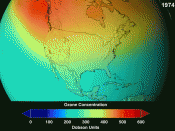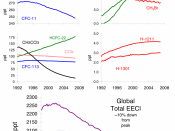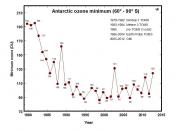- The rate of decline in stratospheric ozone at mid-latitudes has slowed; hence, the projections of ozone loss made in the 1994 Assessment are larger than that has actually occurred.
- The springtime Antarctic ozone hole continues unabated.
- The late-winter/spring ozone values in the Arctic were unusually low in six out of the last nine years, the six being years that are characterized by unusually cold and protracted stratospheric winters.
- The understanding of the relation between increasing surface UV-B radiation and decreasing column ozone has been further strengthened by ground-based observations, and new developed satellite methods show promise for establishing global trends in UV radiation.
- Stratospheric ozone losses have caused a cooling of the global lower stratosphere and global-average negative radiative forcing of the climate system.
- Based on past emissions of ozone-depleting substances and a projection of the maximum allowances under the Montreal Protocol into the future, the maximum ozone depletion is estimated to lie within the current decade or the next two decades, but its identification and the evidence for the recovery of the ozone layer lie still further ahead.
What would have happened without the Montreal Protocol?
One measure of success of the Montreal Protocol and its subsequent Amendments and Adjustments, according to the Assessment, is the forecast of "the world that was avoided" by the Protocol:
- The abundance of ozone-depleting gases in 2050, the approximate time at which the ozone layer is now projected to recover to pre-1980 levels, would be at least 17 ppb of equivalent effective chlorine (this is based on the conservative assumption of a 3% per annual growth in ozone-depleting gases) which is about five times larger than today's value;
- Ozone depletion would be at least 50% at mid-latitudes in the Northern Hemisphere and 70% at mid-latitudes...


